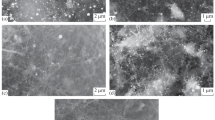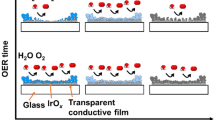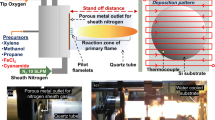Abstract
To improve the performance of air electrodes, the dependence of iron phthalocyanine (FePc) catalytic effects on preparation methods was examined. The methods used were mixture (Electrode 1), impregnation (Electrode 2) and direct synthesis (Electrode 3). Electrodes 2 and 3 showed higher potentials during cathodic polarization up to 10 mA cm−2 than Electrode 1. The rate of chemical destruction of H2O2 decreased in the order Electrode 3 > Electrode 2 > Electrode 1. Electrode 3 showed the smallest potential drop for a discharge at 10 mA cm−2, 0.09 V after 50 h. However, the potential of Electrode 2 decreased with discharge, becoming 0.09 V lower than that of Electrode 3 after a 50 h discharge at 10mA cm−2. Once the potential drop occurred, the potential was not recovered by resting or by drying the electrode. The potential drop may be caused by deactivation of FePc. One possible reason for such deactivation is the presence of H2SO4, which remained on the electrode after impregnation of the FePc-H2SO4 solution.
Similar content being viewed by others
Referencbes
A. Kozawa, V. E. Zluionis and R. J. Brodd,J. Electrochem. Soc. 118 (1971) 1705.
J. Zagal, P. Bindra and E. Yeager,ibid. 127 (1980) 1506.
R. J. Brodd, V. Z. Leger, R. F. Scarr and A. Kozawa, National Bureau of Standards Special Publication,455 December (1974) 253.
M. Savy, C. Bernard and G. Magner,Electrochim. Acta 20 (1975) 383.
A. J. Appleby, J. Fleisch and M. Savy,J. Catal. 44 (1976) 281.
A. Kozawa, V. E. Zilionis and R. J. Brodd,J. Electrochem. Soc. 117 (1970) 1470.
L. Kreja and A. PlewkaElectrochim. Acta 27 (1982) 251.
A. J. Appleby and M. Savy,ibid. 21 (1975) 567.
H. Meier, W. Albercht, V. Jshirwitz and E. Zimmerhackl,Ber. Bunsenges. Phys. Chem. 77 (1973) 843.
R. Jasinski,J. Electrochem. Soc. 112 (1965) 526.
L. Kreja and A. Plewka,Electrochim. Acta 25 (1980) 1283.
T. Hirai, J. Yamaki and A. Yamaji,J. Appl. Electrochem. in press.
Y. Bansho, J. Kuwabara, T. Sekiguchi and K. Yamanari,J. Chem. Soc. Jpn. (1972) 1712 in Japanese.
Y. Hosoda, ‘Senryo Kagaku’ Gihou-do, Tokyo (1973), in Japanese pp. 386–95.
J. R. Golstein and A. C. C. Tseung,J. Phys. Chem. 76 (1972) 3646.
Author information
Authors and Affiliations
Rights and permissions
About this article
Cite this article
Hirai, T., Yamaki, JI. & Yamaji, A. The influence of catalyst-supporting methods on electrochemical activity and the resultant stability of air electrodes activated with iron phthalocyanine. J Appl Electrochem 15, 441–445 (1985). https://doi.org/10.1007/BF00615997
Received:
Revised:
Issue Date:
DOI: https://doi.org/10.1007/BF00615997




